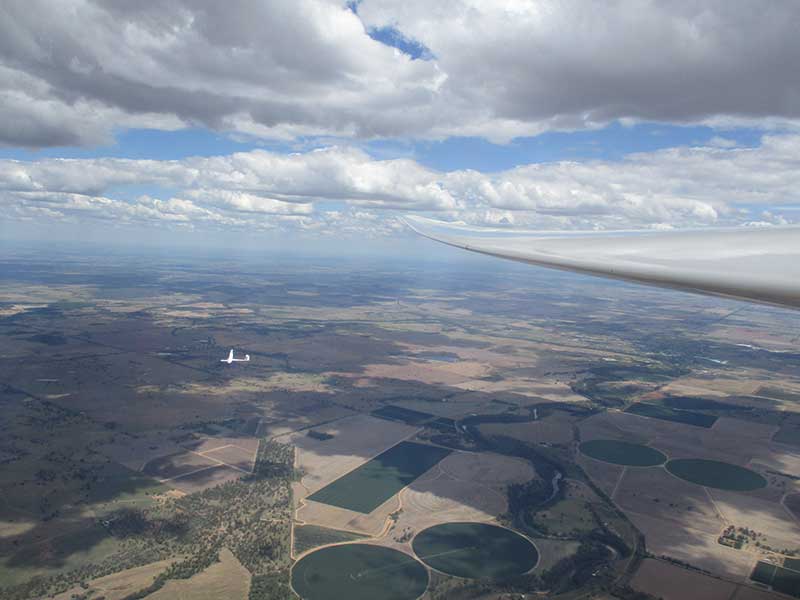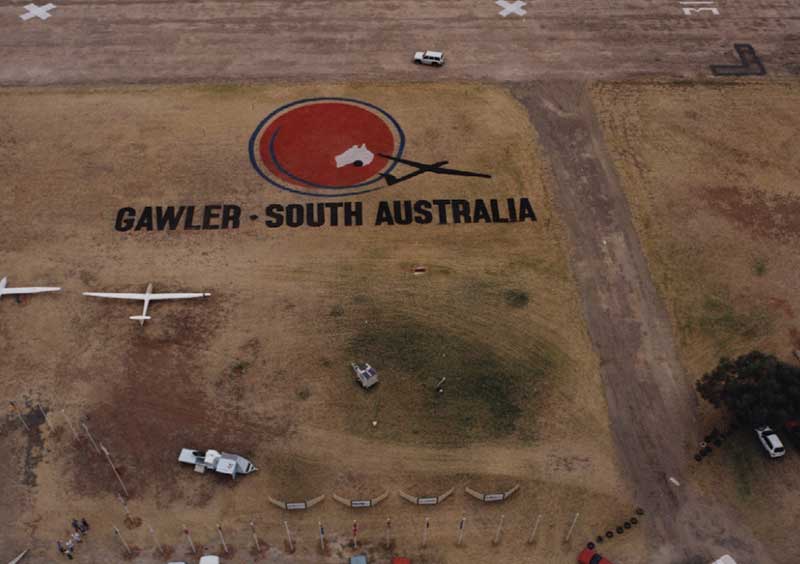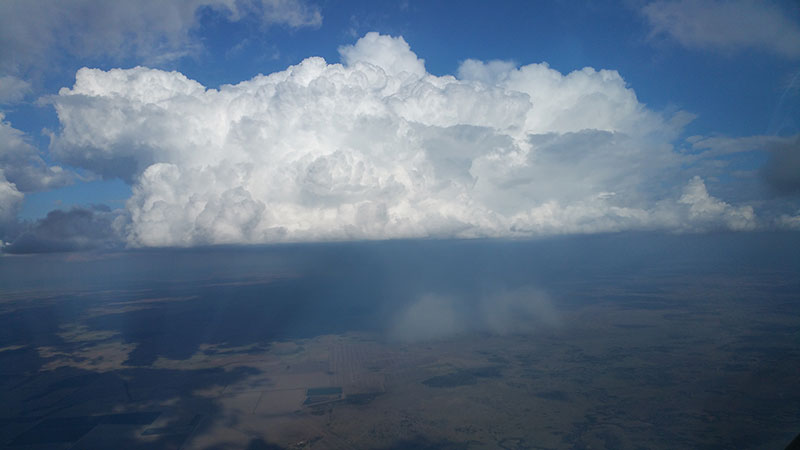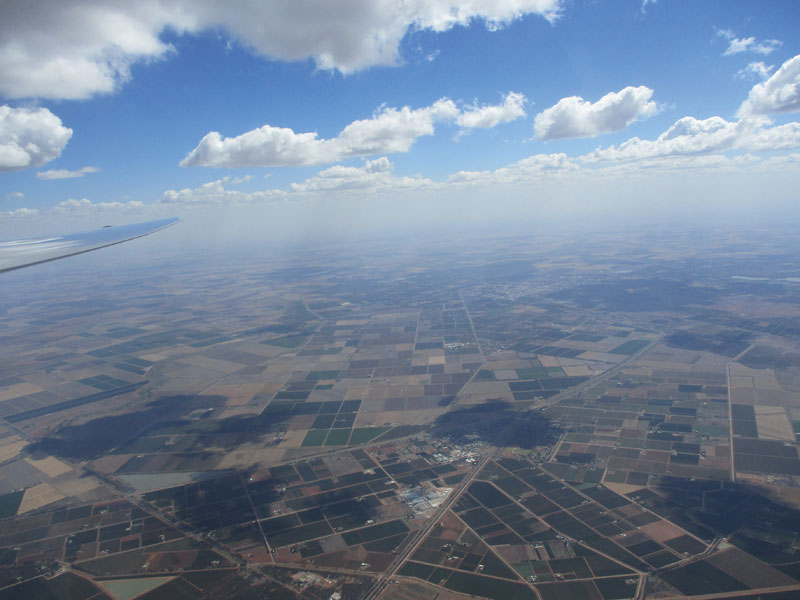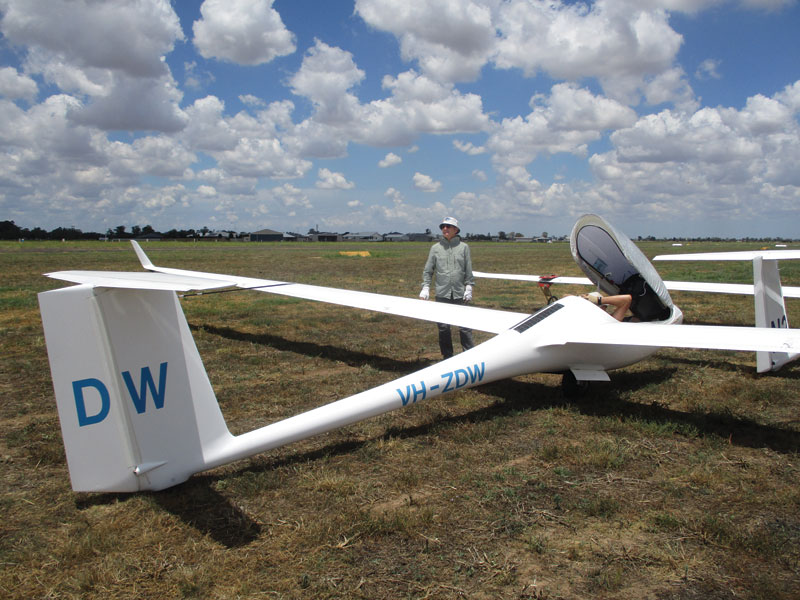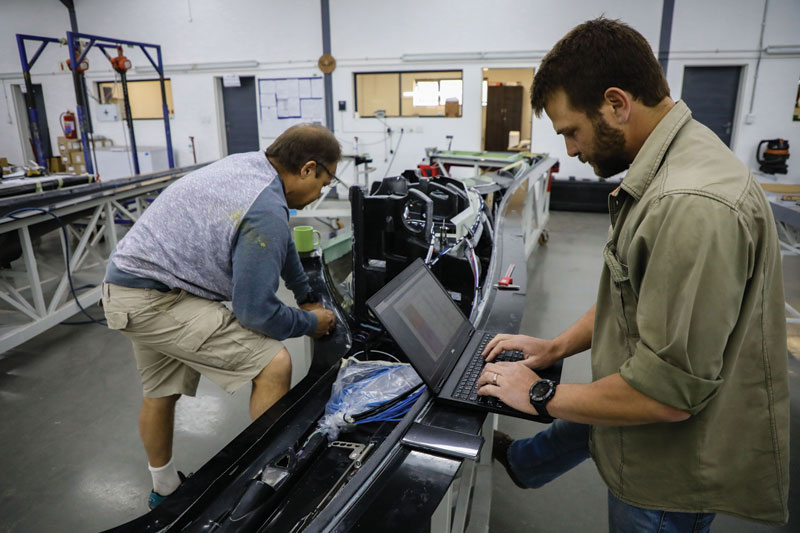
Allan Barnes and Harry Medlicott landiing the Arcus at Szeged.
By Allan Barnes and Sean Young
Sean Young - Good Weather but Challenging Circumstances
The World Gliding Championships in 20m multi-seat, 18m and Open Classes was held at Szeged in the south of Hungary near the Serbian border in July and August. The competition took place under the shadow of Russia’s invasion of Ukraine, which borders Hungary. The competition site was moved to Szeged when the war began as the airfield the organisers had chosen originally is very close to Ukraine. It also took place under the shadow of COVID 19, which caused the rescheduling of the championships from 2020 to 2022.
Allan Barnes and Harry Medlicott had decided to compete in the 20m Multi-Seat Class just a few months before the championships. Overcoming the challenges and concerns caused by the pandemic and war, they persevered and were the only Australians to take part.

Allan and Harry at the Australian Headquarters.
They were accompanied by a small crew including Harry’s partner Wendy, Jacob Bloom, Andrew White and Katie Fobbe.
As I was not far away in France, I decided to pay a visit to Szeged to offer support. I arrived in the city on the official rest day, after six racing days, and the next morning made my way to the airfield, which is on the outskirts of the city, for daily briefing. There, I found Allan and Harry, on their own without any of their support crew who were all recovering from or in the midst of COVID infections. Harry had also suffered a bout of the virus in Szeged but had recovered in time to fly the championships.
Allan said, ‘The level of competition has been very high. All the pilots are very good and flying well, which has made the point spread very narrow. On day 6, we were only 108 points behind the leader but came in at 13th position for the day.’

Allan and Harry ready to launch on another long task. Eleven tasks were flown in the contest with distances from 450 - 650km each day.
Harry had recently turned 90 years old, making him the oldest person ever to compete in a WGC. He said, ‘The competition has been very tough. Everyone is flying at the top of their game. Allan and I fly well together. We have the same notion of where to go in the sky.’
For the last few years some gliding competitions have been using a Pilot Event Button (PEV) in an effort to discourage excessive pre-start gaggling and waiting. Pilots must push the PEV five minutes before they intend to start. If they start before the five minutes is up, they receive a 50 point penalty. After the 5 minutes has elapsed they have an additional 8 minutes to launch. They can push the PEV three times, after which they must start.
Allan said, ‘This is having some effect in preventing pre-start games.’

Allan and Harry with crew Wendy Medlicott back on duty.

The Australian team and crew at the opening ceremony. Left to right - Jacob Bloom, Andrew White, Wendy and Harry Medlicott, Allan Barnes and Katie Fobbe.
The Weather
Unlike so many gliding championships, the weather provided many excellent soaring days. A series of heatwaves was gripping southern Europe, and Hungary had been hot and dry for many weeks. Every day the temperature was in the mid 30s and early on in the contest the mercury had reached 43 C. Most days had cumulus but some, like the final day, had large areas of blue sky conditions.There were tricky days, as to be expected. But eleven competition days were flown, many with very long tasks and high speeds in all classes.
The Contest
In all, 83 gliders took part in the contest with 43 in 18m Class, 19 in 20m Multi-Seat Class and 18 in Open Class. Fortunately, the Szeged airfield is large and, even with all the gliders on the grid or coming in to land, there was plenty of room to accommodate them.
Many of the top competition pilots in the world took part in the championships. Previous world champions were competing across all three classes. Some countries, notably France and Germany, sent over large, well-funded, well-organised teams, while other nations, such as Slovenia, sent just one pilot – and no crew at all.
Japan had two pilots including Mac Ichikawa from Australia who flew in 18m class. He was one of four pilots to fly an AS 33 ES. But the 18m field was dominated by JS3s, with 21 flying in the competition, and 11 Ventus 3s. Both of these gliders debuted at WGC Benalla in 2017, the JS3 in its 15m version. It was impressive to see how these two models have become so popular with competition pilots.

Tilo Holighaus from Schempp-Hirth paying a visit before launch.
Winners
The 20m class was won by Czech team Ivan Novak and Petr Krejcirik with 8,898 points. Once again, they flew consistently, always at the top of the table. They beat the Polish duo Jakub Barszcz and Lukasz Kornacki who took 2nd place with 8,783 points flying a HpH 304 TS Twin Shark.
Of the contestants in this class, three flew Twin Sharks, and the other 16 gliders were Arcus. At least in the WGCs, the range of glider models flown in this class is very narrow. Most of the gliders in 20m Class were self launchers, as they were in Open Class.
18m Class
After an exciting final race at WGC Szeged, Christophe Abadie from France held onto his lead, coming home in 7th place on the day, but taking the 18m World Gliding Championship title with 8,957 points gained over 11 races.
In second place was Italian Riccardo Brigliadori with 8,856 points, followed in 3rd place by his teammate Davide Schiavotto with 8,843 points. They finished the day in 3rd and 4th places respectively, but their consistent performance over the two competition weeks ensured them of places on the winners' podium.
Open Class
The new Open Class World Gliding Champion is Felipe Levin from Germany with 9,088 points. Felipe finished the race with now former World Champion and teammate Michael Sommer in 8th place. But he kept his overall lead and beat Oscar Goudriaan from South Africa by 72 points.
EB 29s took six of the top ten positions in Open Class while JS1s took the remaining four. The only other model of glider in the field was an ASH31.
There were two pilots from the USA, two from Australia and two from Brasil flying in 20m multi-seat class plus pilots from South Africa and Japan. So although this was mainly a European event, it was a truly worldwide championships.
The townspeople of Szeged have been warm and welcoming and the organisers have achieved a professional, well run competition.

At briefing in an open, well-spaced hangar on the airfield.
Allan Barnes - How the Competition Unfolded
On Day 1 of the Worlds, with a 380km task ahead, we didn't want to wait too long to launch. We had a really good run down the first three legs, but on the fourth leg missed a good climb and ended up out in front, but low. We scraped up from 300m and lost 20 minutes doing it.
Tuesday, 26 July, was another 35 degree day with strong conditions. After the difficulties we had yesterday, we were happy to wait for a gaggle to depart with. However, a major cold front was forecast to hit the airfield in the late afternoon, so we still wanted to leave as early as possible. The task was a 317km 4TP race. We were 4th to leave, which apparently was still too early, but we just didn't want to risk getting caught out by the weather.
The run felt much better than it showed in the scoreboard, with the winner achieving 140kph versus our 124. That was enough to put us way down at 17th place, but at least we came up a place overall! As forecast, the wind picked up to 20kt on the final leg and many of the landings were very interesting to watch, with several ground loops. As we were on downwind I counted 12 gliders in the circuit in front of us. Fortunately it's a big airfield.


Harry and Allan plan their flight after briefing.
Changing Task
Finishing at 140kph on Day 4 of the worlds, we thought we had probably had a good day. Well, it was good enough for 17th. Still, we were less than 100 points off the winner’s score. The day was originally going to be a racing task but changed just before launch to an AAT. Thunderstorms were predicted by 3pm, so 2.5 hours was set.
On the initial leg we were in good company but chose a slightly different TP and second leg. We never got low or slow, the cu were good, and on the final leg we met up with the fleet again. This was lots of fun – we did one surplus turn on final glide and gained enough in the cruise to extend out the 1km timesoak. The storms stayed east of the field, which meant they were out of the task area, but more were forecast for tomorrow.


After coming 2nd in 15m Class at WGC Benalla at this championships Makoto Ichikawa flew in 18m Class for Japan.
Fast and Furious
Today they set a huge task of 642km, and we were last on the grid. It was clear that there would be no hanging around playing start games! Clouds were already forming when we launched, and we quickly climbed and positioned ourselves for an early start at the upwind end of the line.
A few minutes after the gate opened we took off. The first leg was straightforward but some deviation was required to get to the turnpoint on the Danube, which was in the usual blue area. There were quite a few gliders in front of us but of mixed classes, as all three tasks flew similar lines. On the second leg we passed very close to the nuclear power station and stopped for nothing less than 5kt. It was good having other gliders around to pre-centre for us.
The third leg was fast and furious – and very long. We passed within a whisker of the Kecskemet MTMA, but there were good climbs everywhere. After the 3rd turn, we took a big 50 degree deviation to get to better cu and it paid off.
Then, after the 4th turn, we deviated a huge 40 degrees for over 100km to stay upwind and under the clouds, taking the 5th upwind turn fairly low and coming back again to the upwind side with an even greater, almost 90 degree, deviation. One last really strong-looking cu looked like our passport to final glide but it failed to deliver and, after a few minutes of only 2kt, we abandoned it and headed for the wisps on track. These allowed us to make up our final glide without turning, and we joined circuit with nine others in the pattern in front of us. Finally, we had a good result for the day – 4th place, sadly just short of the podium.

Launching on a classic cumulus day.

The view from the cockpit over the flat farmlands of southern Hungary.
Strong Climb
Another fantastic day at the WGC, our task on 3 August was over 500km again, so with the sky looking like it could well overdevelop, nobody hung around too long. We pressed the PEV (pilot event button) just as the window opened, then extended to almost the full 13 minutes before rolling out at cloudbase through the line. With a small fast gaggle we still couldn’t catch the very earliest starters. Down the Danube was a large blue area. We topped up and headed out across it, fortunately finding a strong climb in the blue.
After the second turn, the next leg was 160km, back into the cumulus. We found 6kt but quickly left it when we saw gliders going up faster ahead. On the final glide, we started well below and built it up by weaving through the best energy at high speed. Again, at the finish there were 10 or 12 gliders in circuit as we joined. Somehow it always works itself out!
Memorable
This competition was memorable for its fantastic weather and the quality of the organisation, which was superb. It was also memorable for the enormous health issues that our team faced, and the resulting need to separate those with COVID from those without. Although we were booked in accommodation for the whole time, I personally had to pack up and relocate three times to different hotels as people I was staying with tested positive. In the end, I was the only team member of six to avoid it for the whole time, although often I felt sick enough that I was surprised to test negative.


Many Australian pilots will remember Michael Sommer, 5-time World Champion in Open Class, from his visits to Australia.
Allan Barnes - Team Captain's Report
Australia fielded only one entry - in the 20m 2-seater class. Normally we also have entries in the 18m, and often the Open class.
I took the Team Captain's role as well as flying. Harry and I had our respective partners, Katrin Fobbe and Wendy Medlicott, as well as Andrew White and Jacob Bloom for crew.
Harry has the remarkable and impressive distinction of being the oldest ever competitor at a WGC, and quite possibly, the oldest competitor at any World Championships in any sport.
Preparation
Our preparation time for attending this competition was very short. We did not suspect that we had a place at the competition until March 2022. This is an extremely short period to prepare for a WGC, especially with the added burden that Australian competitors have of getting CASA licenses and then getting them endorsed by foreign government bodies. This process warrants a report on its own, but needless to say, both the Australian and German components were time consuming, tedious, and expensive.
It was immediately obvious that shipping a glider from Australia was not feasible, both because of the short timescales, and because of the current instability in global shipping delivery times. We secured a top-notch Arcus-2M which performed flawlessly throughout.
Szeged is close to the Hungarian borders with Serbia and Romania in the south, and Budapest is only a short distance to the north. So airspace was limited to a relatively narrow east/west corridor. However, the competition was blessed with extremely good conditions. The first week was predominantly blue, with strong thermals, except one day where there were strong winds and overcast conditions at the start. The second week was predominantly cumulus flying, also with strong conditions. We scored 10 days of a possible 13.
Overall, we came 18th out of 19 entries. In large part this can be put down to two extremely expensive errors. On day 6, I elected to use the thistle turnpoint to avoid having to go all the way to the 500m circle - and afterwards realised to my horror that the thistle sectors were no longer in use. This cost some 700 points. On day 10 we clipped airspace by 5m while in a 12-kt thermal. I had not allowed for sufficient buffer in my instrument warnings, and at this WGC there was no graduated penalty buffer zone around airspace. That cost some 900 points. But even without these two errors we would have still have placed only 11th.
On the positive side, we did manage 3 top10 places, and were often within 100 points of the winner, but were just out of reach of the daily podium.
This was the first WGC I have attended where the PEV was in daily use. At first they used a 5 minute pre-start with an 8 minute window. So you could start from 5-13 minutes after pressing the PEV, but could restart it any time after 30 seconds of a press. A maximum of 3 PEVs per flight were allowed. Later in the competition they changed it to a 10 minute pre-start with a 5-minute window, which I believe was intended to reduce gaggling.
Despite this, gaggles quickly formed on task and generally stayed together throughout the flight. Gaggling was clearly the most efficient way by far of getting around the task fast, and the days we had our best results were the days we ‘got on the bus’. What the PEV does tend to reduce is the instances of one pilot following a specific ‘target’ pilot, although the tasks were long enough (316-645km) that there was not too much pre-start gaggling, so it was relatively easy to anticipate that people were about to start.
Contributing Factors to the Australian Performance
I have attended a number of WGC for Australia as team captain, and a number as competitor, but this is the first I have taken on both roles. This adds significant pressure to the task. There were up to 3 Team Captain meetings every day in the first week, with little time for pilot-related tasks in between. The number of meetings was much lower in the second week as team captains rebelled. There was insufficient time for normal pilot planning in the mornings. As team captain I was also responsible for the well being of the rest of the team, and although with COVID there was not a lot I could do, this did weigh heavily on me.
COVID was an enormous stress factor. Initially, Harry tested positive, then two days later, both crew on the same day.
They had to isolate together. Next, Katie tested positive, so we had to arrange for her to move to a different hotel to isolate. The next day Wendy tested positive, so Katie moved back to be in the ‘infected’ house while I moved to yet another hotel to isolate as ‘clean’. A few days later, I moved back, once the original accommodation had the green light. The next day
Harry’s daughter arrived and Katie and I offered to move again to allow the family to be together. Having to move 3 times during a competition does not help one’s focus. To summarise, most of us felt sick to some extent most of the time, and I was the only one to not test positive.
The team experience was on the light side. Despite the crew having not been to a WGC before, and being hit with COVID, they did remarkably well, with Katie and Wendy filling in where needed. There were no real problems with gridding, weighing, or retrieval from the airfield.
The lack of experience also showed at the team tent, which really needs a radio hand who is also an experienced international competition pilot, and competent in analysing weather changes and OGN information in real time. That we didn’t have someone with these skills meant that all the cockpit decision making was a little less well informed.
Summary
A disappointing result for Australia points-wise, but a remarkable achievement by Harry Medlicott to represent his country at 90. Both Harry and I gained a lot from attending, despite the hardships that eventuated.

New 18m World Champion Christophe Abadie landing on the final day of the championships.

Italian Ricardo Brigliadori finishing with Takeshi Maruyama from Japan in 18m Class.
37th World Gliding Championships
Szeged Hungary 24 July - 5 August
20m Multi-seat
1 Ivan Novak / Petr Krejcirik 8,898
2 Jakub Barszcz / Lukasz Kornacki 8,783
3 Steve Jones / Garry Coppin 8,666
18 Allan Barnes / Harry Medlicott 6,508
18M
1 Christophe Abadie 8,957
2 Riccardo Brigliadori 8,865
3 Davide Schiavotto 8,843
Open
1 Felipe Levin 9,088
2 Oscar Goudriaan 9,016
3 Radek Krejcirik 8,646
Full results at soaringspot.com
bit.ly/3w4hAcc






